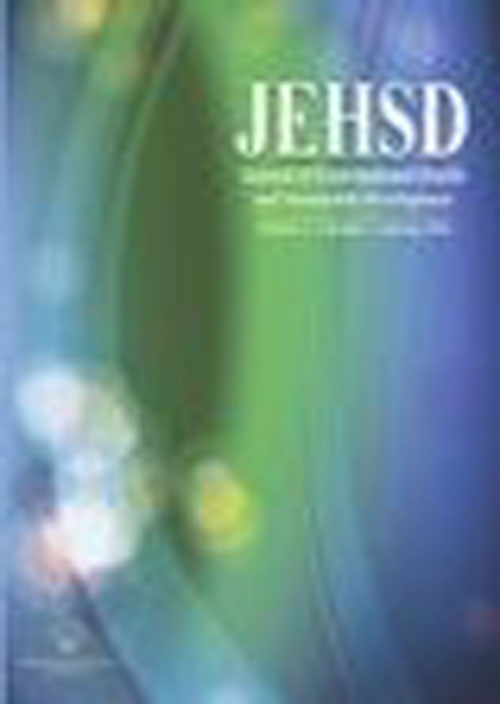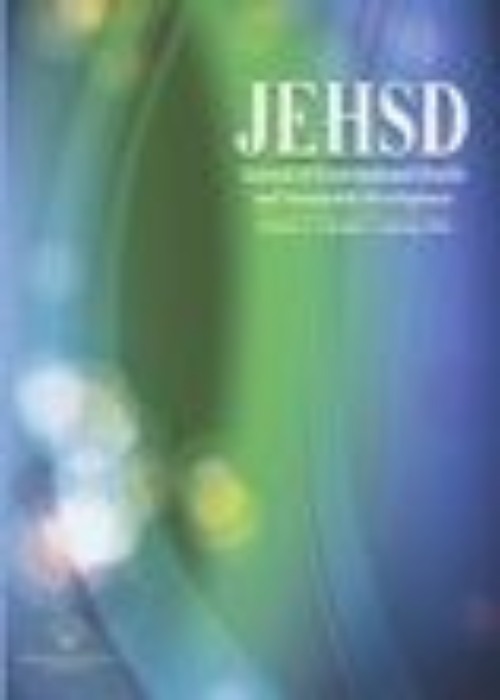فهرست مطالب

Journal of Environmental Health and Sustainable Development
Volume:6 Issue: 4, Dec 2021
- تاریخ انتشار: 1400/10/13
- تعداد عناوین: 8
-
-
Pages 1407-1418Introduction
Extreme weather or climate, including heat waves and cold waves, is considered a health issue causing adverse effects on health, such as cardiovascular diseases (CVDs), mortality and morbidity. Thus, this systematic review aimed to study the impacts of extreme ambient temperature on cardiovascular outcomes.
Material and MethodsThis study was carried out based on the Preferred Reporting Items for Systematic Reviews and Meta-Analyses (PRISMA) protocol. Papers about the ambient temperature and cardiovascular outcomes were searched in the scientific database, including ISI, PubMed, Scopus, and Google Scholar, from January 1970 up to the end of 2020. We used the key terms, such as “heat wave”, “cold wave”, “extreme event”, “cardiovascular disease”, “mortality”, and “morbidity”. The thematic analysis method was used to determine all themes and analyze the data.
ResultsAmong the 7631 searched and extracted papers, 20 articles met the eligibility criteria for including the process of final analysis. Effects of extreme events included mortality, morbidity, and hospitalization due to CVD. A relationship between extreme events and CVD mortality was confirmed for cerebrovascular diseases, including congestive heart failure (CHF), ischemic heart diseases (IHD), myocardial infarction (MI), cardiac arrhythmia, coronary heart disease (CHD), out-of-hospital cardiac arrest (OHCA), acute coronary syndrome (ACS), and blood pressure.
ConclusionThe present study indicated the impact of extreme ambient temperature on CVD outcomes. The findings provided adaptation and preventive measures and strategies which can be used for CVD patients and managers to prevent CVD due to ambient temperature.
Keywords: Temperature, Heat Wave, Cold Wave, Cardiovascular Disease -
Pages 1419-1442Introduction
Macrolides are a group of antibacterial agents. Given their clinical importance, and the consistent rise in resistance among pathogenic bacteria, macrolides have been the targets of extensive research.
Materials and MethodsThis review considered the number of macrolides in different wastewater and the removal of these drugs. The antibiotics were frequently detected in influents and effluents, ranged from ng/L up to lower μg/L. In influent, the highest concentrations of clarithromycin (6080 ng/L), roxithromycin (>103 ng/L), erythromycin (3900 ng/L), and azithromycin (1949 ng/L) were detected in Croatia, Chinese, USA, and Singapore municipal wastewater treatment plants, respectively.
ResultsThe removal efficiency of macrolides during wastewater treatment processes varies and is essentially dependent on a combination of macrolides physicochemical properties, location of municipal wastewater, and the operating conditions of the treatment systems. The application of alternative techniques, including membrane separation, activated carbon adsorption, advanced oxidation processes, biodegradation, and disinfection were the dominant removal routes for macrolides in different wastewater treatment processes. A combination of these techniques can also be used, leading to higher removals, which may be necessary before the final disposal of the effluents or their reuse for irrigation or groundwater recharge.
ConclusionMany antibiotics cannot be removed completely in wastewater treatment processes and would enter into the environment via effluent and sludge. The molecular structure of macrolides and their load-bearing capacity has led to the advantage of biological treatment over other treatments. However, the main part of the treatment has been done using biological treatment.
Keywords: Wastewater Treatment, Macrolide, Environment -
Pages 1443-1448Introduction
One of the ways of human exposure to aluminum (Al) is Al food packaging materials and cookwares. Although many studies have examined the biotic influence of nanoparticles or ionic form of heavy metals, there are limited studies conducted on the possible health risks of metals in the form of alloy used for making utensils. In this study, the effect of water boiled in Al cookwares with defined concentrations of Al on the genomic abnormalities and cell division of meristematic cells of onion root was evaluated using Allium cepa assay.
Materials and MethodsThe onion roots were treated with water boiled in Al utensils (three pots) with different concentrations of Al (5 and 10 mg/l) for 42 to 43 hours and then analyzed for mitotic index (MI) and mitotic phase aberrations (MPA).
ResultsThe percent of MI in the study groups treated with 5 mg/l of Al from pot 1 and 10 mg/l from all pots increased significantly compared to the control group (P < 0.05). Also, the frequency of total MPA in all Al treated groups significantly increased compared to the control group (P < 0.05). The most significant results were derived by sticky chromosomes, anaphase bridge, going ahead chromosome and disturbed mitosis, respectively.
ConclusionThe result of this study confirmed the genotoxic effect of water boiled in Al cookwares containing the examined range of Al concentrations on the meristematic cells of onion root.
Keywords: Mitotic Index, Genome, Aluminum -
Pages 1449-1458Introduction
Food insecurity has negative impacts on health, including the function of the immune system. The association between food insecurity and COVID-19 infection rates has not been fully understood. This study aimed to examine whether food-insecure households are more vulnerable to COVID-19 infection.
Materials and MethodsThis online cross-sectional study was conducted on 2,871 Iranian adults (31 provinces), from August to September 2020. Demographic and socio-economic information was collected using a questionnaire. The Household Food Insecurity Access Scale (HFIAS) was used for assessing household food insecurity. The data analysis was performed by SPSS.22, using Chi-square test, ANOVA test, and Multinomial Logistic Regression Model.
ResultsThe findings indicated that healthcare personnel were at higher risk of COVID-19 (CI = 1.90, 7.05; OR = 3.66; P < 0.001). It was also shown that HFIAS scores were significantly higher among infected people compared to non-infected (CI = 1.00, 1.05; OR = 1.03; P < 0.05). Women were at lower risk of infection compared to men (CI = 0.41, 0.87; OR = 0.60; P < 0.05).
ConclusionsBased on the results, in addition to long-term policies to improve food security, policymakers are recommended to implement short-term policies to reduce the vulnerability of the community to COVID-19 virus.
Keywords: COVID-19, Pandemics, Health Personnel, Food Insecurity -
Pages 1459-1475Introduction
The present study investigated one of these types of disease (skin cancer) and its relationship with climatic parameters. The aim of this study was to investigate the relationship between climate change and skin cancer in Ardabil province.
Materials and MethodsThis descriptive correlational study was conducted to investigate the effect of six climatic parameters (frost, sunny hours, minimum mean humidity, maximum absolute temperature, minimum absolute temperature, and mean temperature) on skin cancer in Ardabil province in a 3-year statistical period (2012-2014). The data were analyzed using the Spearman correlation relationship in SPSS version 24 software, also Minitab version 16 software was used for linear interpolation.
ResultsAccording to the findings, the highest correlation (more than 95%) of skin cancer in three cities of Parsabad, Khalkhal, and Ardabil with the climatic parameter was related to minimum absolute temperature. However, in Khalkhal station in three years of study, sunny hours had the highest correlation and the lowest correlation was related to glacial climate parameter in all four cities. It can be said that the factors of sunny hours and maximum temperature have an effect on the incidence of skin cancer, and the minimum absolute temperature increases the exacerbation of this type of disease.
ConclusionAccording to the results of statistical correlation and the effects of climatic parameters on skin cancer, it can be concluded that climate parameters are one of the effective factors in skin cancer.
Keywords: Climate, Demography, Skin Cancer, Ardabil Province -
Pages 1476-1493Introduction
Global warming is one of the most important environmental problems that have raised researchers’ attention. The present study aimed to analyze heat stress trends using the Wet Bulb Globe Temperature (WBGT) index in the country of Iran during the summer over a 30-year period.
Materials and MethodsDaily summertime statistical data regarding mean temperature and mean relative humidity, taken from 40 synoptic meteorological stations across Iran during a 30-year period were obtained from the Iranian National Meteorological Department. The De Martonne climate classification system was used to categorize various climate regions of Iran. The WBGT index was calculated using the formula given by the Australian Bureau of Meteorology. The Mann-Kendall statistical test and the Sen's slope estimator were used to analyze the trends of the WBGT index.
ResultsThe WBGT index had an upward trend during the three months of June, July, and August in 71.42%, 57.14%, and 66.66% of all stations and this trend was statistically significant in 53.32%, 50%, and 42.85% of those stations, respectively. Moreover, throughout the summer, 45% of the WBGT index measurements were in the medium range (18-23°C), 37.5% were in the high range (23-28°C), and 17.5% were in the very high range (> 28°C).
ConclusionThe WBGT index followed an upward trend during the summer, especially in semi-arid regions of Iran. Considering the phenomenon of global warming, it is essential to monitor, plan ahead, and take necessary precaution measures for sensitive populations who are at high risk areas of the country.
Keywords: Heat Stress, Wet Bulb Globe Temperature, Trend Analysis, Iran -
Pages 1494-1506Introduction
Safety and health risk assessment in industries is associated with uncertainties due to the variables affecting it. Therefore, in this research, optimizing safety and health risk assessment was investigated in construction sites by combining a multi-criteria decision-making technique (TOPSIS) and a fuzzy system. In the present study, to answer this question, a new method was used to optimize health risk assessment in construction workshops.
Materials and MethodsThe case study was construction sites in Lar, a city in the south of Iran. Based on previous studies and expert opinions, ten criteria were determined to assess safety and health risks in the construction sites. Also, 15 safety and health risks were identified resulting from 12 types of activities in the construction sites. Triangular fuzzy numbers were used for linguistic variables in Fuzzy TOPSIS with R version 1.1 software.
ResultsBased on the results, the risk of the collapse of adjacent buildings related to the excavation process was the most important safety and health risk in the construction sites with a coefficient value of 0.5.
ConclusionThis method can provide desired results with the least uncertainty in prioritizing safety and health risks.
Keywords: Risk Assessment, Safety, Health, Fuzzy Topsis, Lar City -
Pages 1507-1521Introduction
Inappropriate management of mining activities may bring about water pollution and pose a heavy complication on aquatic ecosystem and humans. The study aimed to evaluate the effect of Qorveh gold mining activities on the quality of nearby groundwater.
Materials and MethodsThe concentration of seven eco-toxic metals along with some general hydrochemical parameters were investigated for 27 sampling stations in the study area using Atomic Absorption Spectrometry (AAS) and conventional hydrochemical methods. The analysis results were further applied to compute pollution indices, namely heavy metal pollution index (HPI) for irrigation purposes.
ResultsThe main elements were within the World Health Organization (WHO) and Iranian National Water Standards (INWS) for irrigation water quality, except for NH4+ in some sampling points. The concentration of heavy metals followed the order Cu > Zn > Pb > Hg > Cd > As. The contents of Hg, As, Cd, and Cu in most sites were higher than the recommended values. Except for two stations, the value of HPI based on the mean concentration was found to be far beyond the critical pollution index value of 100, suggesting that the area is highly polluted with some heavy metals.
ConclusionElevated concentration of trace elements found in groundwater of this area represented the release of harmful elements from gold mining activities on surrounding environment.
Keywords: Metals, Heavy, Hydrochemistry, Groundwater, Qorveh City


